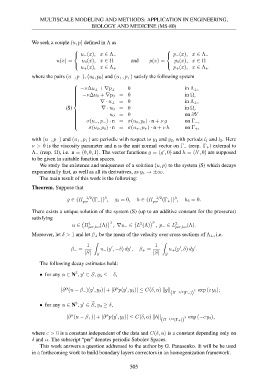Page 507 - 8th European Congress of Mathematics ∙ 20-26 June 2021 ∙ Portorož, Slovenia ∙ Book of Abstracts
P. 507
TISCALE MODELING AND METHODS: APPLICATION IN ENGINEERING,
BIOLOGY AND MEDICINE (MS-80)
We seek a couple (u, p) defined in Λ as
u−(x), x ∈ Λ− p−(x), x ∈ Λ−
u(x) = u0(x), x ∈ Ω and p(x) = p0(x), x ∈ Ω
u+(x), x ∈ Λ+ p+(x), x ∈ Λ+
where the pairs (u−, p−), (u0, p0) and (u+, p+) satisfy the following system
−ν∆u± + ∇p± = 0 in Λ±,
in Ω,
in Λ±,
−ν∆u0 + ∇p0 = 0 in Ω,
on ∂Y
on Γ−,
on Γ+,
∇ · u± = 0
(S) ∇ · u0 = 0
u0 = 0
σ(u−, p−) · n = σ(u0, p0) · n + ν g
σ(u0, p0) · n = σ(u+, p+) · n + ν h
with (u−, p−) and (u+, p+) are periodic with respect to y1 and y2, with periods l1 and l2. Here
ν > 0 is the viscosity parameter and n is the unit normal vector on Γ− (resp. Γ+) external to
Λ− (resp. Ω), i.e. n = (0, 0, 1). The vector functions g = (g , 0) and h = (h , 0) are supposed
to be given in suitable function spaces.
We study the existence and uniqueness of a solution (u, p) to the system (S) which decays
exponentially fast, as well as all its derivatives, as y3 → ±∞.
The main result of this work is the following:
Theorem. Suppose that
g ∈ (Hp−e1r/2(Γ−))3, g3 = 0, h ∈ (Hp−e1r/2(Γ+))3, h3 = 0.
There exists a unique solution of the system (S) (up to an additive constant for the pressures)
satisfying
u ∈ Hp1er,loc(Λ) 3 , ∇u− ∈ L2(Λ) 9 , p− ∈ L2per,loc(Λ).
Moreover, let δ > 1 and let β± be the mean of the velocity over cross sections of Λ±, i.e.
1 u−(y , −δ) dy , 1 u+(y , δ) dy .
β− = |S| β+ = |S|
S S
The following decay estimates hold:
• for any α ∈ N3, y ∈ S, y3 ≤ −δ,
|∂α(u − β−)(y , y3)| + |∂αp(y , y3)| ≤ C(δ, α) g ( )H−1/2(Γ−) 3 exp (c y3);
• for any α ∈ N3, y ∈ S, y3 ≥ δ,
|∂α(u − β+)| + |∂αp(y , y3)| ≤ C(δ, α) h ( )H−1/2(Γ+) 3 exp (−c y3),
where c > 0 is a constant independent of the data and C(δ, α) is a constant depending only on
δ and α. The subscript “per” denotes periodic Sobolev Spaces.
This work answers a question addressed to the author by G. Panasenko. It will be be used
in a forthcoming work to build boundary layers correctors in an homogenization framework.
505
BIOLOGY AND MEDICINE (MS-80)
We seek a couple (u, p) defined in Λ as
u−(x), x ∈ Λ− p−(x), x ∈ Λ−
u(x) = u0(x), x ∈ Ω and p(x) = p0(x), x ∈ Ω
u+(x), x ∈ Λ+ p+(x), x ∈ Λ+
where the pairs (u−, p−), (u0, p0) and (u+, p+) satisfy the following system
−ν∆u± + ∇p± = 0 in Λ±,
in Ω,
in Λ±,
−ν∆u0 + ∇p0 = 0 in Ω,
on ∂Y
on Γ−,
on Γ+,
∇ · u± = 0
(S) ∇ · u0 = 0
u0 = 0
σ(u−, p−) · n = σ(u0, p0) · n + ν g
σ(u0, p0) · n = σ(u+, p+) · n + ν h
with (u−, p−) and (u+, p+) are periodic with respect to y1 and y2, with periods l1 and l2. Here
ν > 0 is the viscosity parameter and n is the unit normal vector on Γ− (resp. Γ+) external to
Λ− (resp. Ω), i.e. n = (0, 0, 1). The vector functions g = (g , 0) and h = (h , 0) are supposed
to be given in suitable function spaces.
We study the existence and uniqueness of a solution (u, p) to the system (S) which decays
exponentially fast, as well as all its derivatives, as y3 → ±∞.
The main result of this work is the following:
Theorem. Suppose that
g ∈ (Hp−e1r/2(Γ−))3, g3 = 0, h ∈ (Hp−e1r/2(Γ+))3, h3 = 0.
There exists a unique solution of the system (S) (up to an additive constant for the pressures)
satisfying
u ∈ Hp1er,loc(Λ) 3 , ∇u− ∈ L2(Λ) 9 , p− ∈ L2per,loc(Λ).
Moreover, let δ > 1 and let β± be the mean of the velocity over cross sections of Λ±, i.e.
1 u−(y , −δ) dy , 1 u+(y , δ) dy .
β− = |S| β+ = |S|
S S
The following decay estimates hold:
• for any α ∈ N3, y ∈ S, y3 ≤ −δ,
|∂α(u − β−)(y , y3)| + |∂αp(y , y3)| ≤ C(δ, α) g ( )H−1/2(Γ−) 3 exp (c y3);
• for any α ∈ N3, y ∈ S, y3 ≥ δ,
|∂α(u − β+)| + |∂αp(y , y3)| ≤ C(δ, α) h ( )H−1/2(Γ+) 3 exp (−c y3),
where c > 0 is a constant independent of the data and C(δ, α) is a constant depending only on
δ and α. The subscript “per” denotes periodic Sobolev Spaces.
This work answers a question addressed to the author by G. Panasenko. It will be be used
in a forthcoming work to build boundary layers correctors in an homogenization framework.
505


